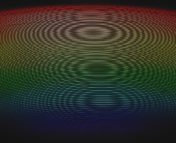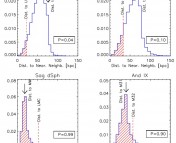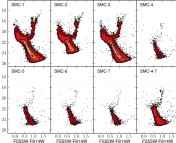This guest post was written by Amy Miller, a graduate student in physics at Montana State University. She uses large surveys to study satellite galaxies of our Milky Way, particularly the Large and Small Magellanic Clouds.
Authors: Helmut Jerjen, Blair C. Conn, Dongwon Kim, and Mischa Schirmer
First Author’s Institution: Research School of Astronomy and Astrophysics, Australian National University, Canberra, Australia
Status: Submitted to arXiv: 1809.02259v1
What’s a Dwarf Satellite and Why Do We Care?
Dwarf galaxies are believed to be the fundamental building blocks of larger galaxies like our Milky Way and are the most abundant galaxies in our known universe. Astronomers use the terms “satellite” or “companion” galaxy to denote less massive galaxies that orbit around a larger galaxy’s center of mass. Two of the most well-known dwarf galaxies are the Large and Small Magellanic Clouds—satellite galaxies of the Milky Way. Though vitally important to galaxy formation and evolution, astronomers have a difficult time producing adequate numbers of them in cosmological simulations. Computer simulations that test the Lambda Cold Dark Matter (ΛCDM) model—the standard model of Big Bang Cosmology—predict that there should be at least 100, and possibly up to a 1000, satellite galaxies orbiting the Milky Way. However, there are only about 50 known Milky Way companions. This huge discrepancy between theory and observation has been dubbed the “missing satellites problem.” Solutions to this problem are a hot topic of debate in the astronomy community.
Meanwhile, increasingly sensitive data are revealing more Milky Way dwarf satellite candidates. Recent work done in two separate papers led by K. Bechtol and A. Drlica-Wagner revealed 16 new Milky Way dwarf satellite candidates in ~5000 square degrees of the southern sky. These candidates were found by analyzing astronomical data catalogs from the Dark Energy Survey and identifying overdensities of stellar populations. Although these 16 overdensities were previously unidentified, it is still unclear as to whether they are dwarf satellite galaxies or star clusters. By gathering more light to see even fainter stars, the subject of today’s Astrobite uses “deeper” images than the Dark Energy Survey to further investigate the exact nature of four of these stellar populations. These deeper data give more information to the authors and allow them to make better estimations as to whether they are dwarf galaxies or star clusters.
Calculating Properties of the Four Dwarf Candidates
In order to calculate the properties of the four overdensities, the authors use g (green) band and r (red) band data gathered using the Gemini South Telescope over three nights in 2016. The authors compare the brightness and colors of the stars in these stellar populations to isochrones, or models of a stellar population with similar populations (iso meaning same, chrone meaning age). By finding the best fitting isochrones, the authors measure the mean ages, mean contents of iron, and distances to the Sun. They also estimate stellar structural properties of the overdensities (positions, position angle from north to east, ellipticity, and size) by exploring spatial distributions of these galaxies on the sky using maximum likelihood analysis—a method of estimating the parameters of a statistical model given observations.
The Four Dwarf Candidates: Horologium I, Pictor I, Grus I, and Phoenix II
The authors calculate properties of these overdensities, shown in Figure 1, and come to new conclusions about their exact nature. Horologium I is located at the edge of the Magellanic Stream at about 68 kpc from the Sun (for reference, the Sun is 8 kpc from the center of the Milky Way) and is the only candidate that shows the existence of two distinct stellar populations. Pictor I and Grus I are both likely to be outer Milky Way system objects and are 120 kpc and 115 kpc from the sun, respectively. Finally, Phoenix II is about 80 kpc from the Sun and is probably a current satellite of the Magellanic Clouds. Compellingly, the authors suggest that each of these objects was once a satellite of the Large Magellanic Cloud (LMC), but they have all been torn from the LMC by tidal forces. Based on structural and stellar population parameters, the authors conclude that Pictor I and Phoenix II are most likely star clusters and Horologium I and Grus I are most likely dwarf galaxies.

Figure 1: The four dwarf candidates (Pictor I ( Pic I), Horologium I (Hor I), Phoenix II ( Phe II), and Grus I (Gru I)) with respect to the Large Magellanic Cloud (LMC), Small Magellanic Cloud (SMC), and the Magellanic Stream. Colors denote the density of gas, with brighter colors indicating more dense environments. The coordinate system used here is the Magellanic Stream coordinate system centered on the LMC, defined in a 2008 paper by David Nidever et al.
Moving Forward
The authors present intriguing evidence about the exact nature of faint stellar overdensities found from the Dark Energy Survey in 2015 by analyzing four dwarf candidates using deeper imaging data. To conclusively confirm whether these overdensities are star cluster or dwarf galaxies, spectroscopic data must be gathered and analyzed to attain more accurate iron abundances, ages, and masses. However, spectroscopic data is more expensive and time-intensive to gather; the observations made by the authors still help shed new light on these objects. Continuing study of Milky Way dwarf satellites is imperative, as both physicists and astronomers use them to test theories of galaxy formation and the ΛCDM model. It is exciting to imagine when astronomers will have finally searched for dwarf galaxies in the entire ~40,000 square degrees of sky and can bring the census of Milky Way companions to a close!




